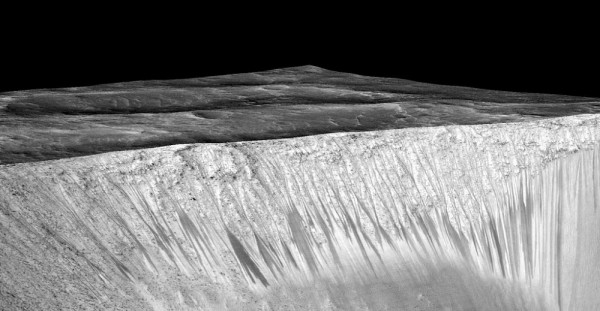By Ana Verayo, | May 03, 2016

Dark narrow streaks, called "recurring slope lineae," emanate from the walls of Garni Crater on Mars, in this view constructed from observations by the High Resolution Imaging Science Experiment (HiRISE) camera on NASA's Mars Reconnaissance Orbiter.
Scientists simulated in laboratory conditions how the mysterious dark lines on Mars have formed, suggesting that these Martian slopes are created by water, but unlike any force here on Earth.
Like Us on Facebook
A team of researchers built models to simulate Martian environments to support a 2015 study that involves the strongest evidence of liquid water on the dusty, alien world, which means the possibility of life. However, scientists still argue that due to Mars' atmospheric low pressure, water cannot survive in a liquid state, which means that it can only boil or freeze over.
In this new study however, researchers used laboratory conditions to explain and prove how water on Mars could have made these distinct marks on the surface. The research team is led by Marion Masse from the University of Nantes in France, along with the same authors who also made the historical study about the existence of liquid water on Mars last year.
During the experiments, the researchers placed a block of ice on a plastic slope measuring 30 degrees, containing loose, fine sand particles. They then let it melt inside a chamber that simulated the air pressure on Mars and summer temperatures on the alien world. After this, they repeated the same experiment under Earth conditions to compare the results.
The results revealed that under Martian pressure, scientists discovered that melting ice created a liquid that boiled intensely when it was flowing downwards the slope, which was filtered into the sand particles. The next process involved how the water vapor that evaporated, pushed these grains above the surface, that created these distinct ridges that collapsed in itself when they became too steep, that ultimately formed these channels.
According to Wouter Marra from the University of Utrecht in the Netherlands, these morphologies that formed on the sandy slopes during the experiments are remarkably similar to the streaks found on Martian terrain.
This sort of unique, active geological process can cause unstable boiling water to boost grains upward and trigger slope failures, providing clues how other landforms on Mars were made. This new study is published in the journal, Nature Geoscience.
-
Use of Coronavirus Pandemic Drones Raises Privacy Concerns: Drones Spread Fear, Local Officials Say

-
Coronavirus Hampers The Delivery Of Lockheed Martin F-35 Stealth Fighters For 2020

-
Instagram Speeds Up Plans to Add Account Memorialization Feature Due to COVID-19 Deaths

-
NASA: Perseverance Plans to Bring 'Mars Rock' to Earth in 2031

-
600 Dead And 3,000 In The Hospital as Iranians Believed Drinking High-Concentrations of Alcohol Can Cure The Coronavirus

-
600 Dead And 3,000 In The Hospital as Iranians Believed Drinking High-Concentrations of Alcohol Can Cure The Coronavirus

-
COVID-19: Doctors, Nurses Use Virtual Reality to Learn New Skills in Treating Coronavirus Patients







